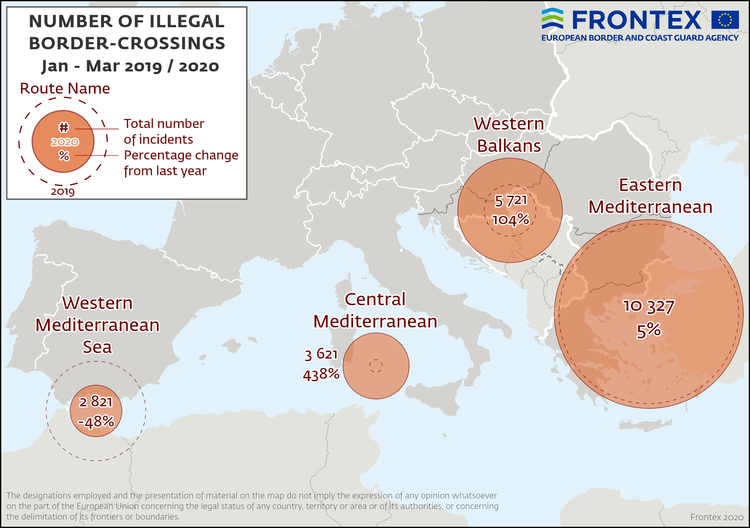In March, the number of detections of illegal border crossings on Europe’s main migratory routes fell by nearly half from the previous month to around 4 650*. The total number of illegal border crossings for the first quarter reached 24 500, up 26% from the same period of 2019.
Eastern Mediterranean
The Eastern Mediterranean migratory route accounted for half of the detections of illegal border crossings into Europe last month. The number of migrants taking this path into Europe fell 38% from February to around 2 300**, despite the spike in detections early in the month.
Frontex, the European Border and Coast Guard Agency, currently deploys 620 officers along the Greek land and maritime borders. These include officers providing additional support to Greece in the form of rapid border intervention operations launched in mid-March at the land and sea borders.
In the first three months of 2020, more than 10 300 illegal border crossings were detected on this route, or 5% more than a year ago.
Afghans were the top nationality detected on this route, accounting for more than one out of every three irregular migrants detected, followed by Syrian and Turkish nationals.
Central Mediterranean
The
number of irregular migrants crossing the Central Mediterranean in
March fell by 88% from the previous month to 200. The total for the
first quarter reached 3
600, a four-fold increase compared to the first three months of 2019.
The top three nationalities detected on this route were nationals of Bangladesh, Sudan and Somalia.
Western Mediterranean Sea
The
number of migrants arriving in Europe via the Western Mediterranean Sea
route in March fell by nearly two-thirds from February to 450. In the
first quarter, the
total stood at slightly above 2 800, or half the year-ago figure.
Algerians and Moroccans accounted for the largest number of migrants detected on this route in the first quarter.
Western Balkans
There
were more than 1 100 detections of illegal border crossings recorded on
this route in March, down 45% from the previous month. However, in the
first three months,
the number of illegal border crossings doubled from the same period of
last year to more than 5 700.
Nationals of Syria and Afghanistan accounted for most of the migrants detected on this route.
*The figure includes other less active migratory routes not mentioned in this press release.
**March 2020 data does not include the number of detections in Cyprus.
Note:
The preliminary data presented in this statement refer to the number of
detections of irregular border-crossing at the external borders of the
European Union.
The same person may attempt to cross the border several times in
different locations at the external border.
